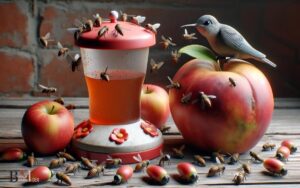How Do Hummingbirds Attract a Mate: Discover the Secrets!
Hummingbirds attract mates through a series of distinctive behaviors and displays, which include colorful plumage exhibition, unique flight patterns, and vocalizations.
Male hummingbirds often engage in elaborate aerial shows, dive bombing, and tail feather displays to catch the attention of females.
To elaborate on the mating rituals of hummingbirds:
For instance, the male Anna’s hummingbird performs a sky dive from up to 130 feet in the air, reaching speeds that produce a distinct sound with their tail feathers, which is intended to impress watching females.
The courtship dance of hummingbirds is a mesmerizing ritual that combines visual and acoustic elements to allure mates.

Key Takeaway
Hummingbird Mating Rituals: Behaviors and Displays
| Behavior | Description | Purpose of Behavior |
|---|---|---|
| Plumage Display | Males exhibit bright, iridescent feathers. | To visually attract females. |
| Aerial Displays | Includes dives and acrobatic flights. | To showcase strength and agility. |
| Vocalizations | Singing and sound production using body parts. | To communicate and woo females. |
| Territorial Defense | Defending the chosen area from rivals. | To ensure a safe place for courtship. |
Unique Courtship Displays
While hummingbirds attract a mate through various methods, they particularly stand out for their unique courtship displays.
Male hummingbirds often perform elaborate aerial displays to attract females, showcasing their agility and speed.
These displays involve rapid dives, U-shaped flights, and impressive mid-air maneuvers, all while producing a distinct humming sound with their wings.
The male will also often display his vibrant throat patch, or gorget, to the female, using it as a way to capture her attention and demonstrate his suitability as a mate.
These courtship displays are crucial in the mating process, as they allow the female to assess the male’s fitness and genetic quality.
Dazzling Plumage and Colors
Male hummingbirds display their vibrant plumage and colors as a visual attraction to potential mates, showcasing their genetic quality and fitness.
The iridescent feathers, particularly on the throat and head, produce vibrant colors due to the microscopic structure of the feathers that refract and reflect light.
These colors are often used in courtship displays, where males perform aerial acrobatics to show off their iridescent plumage to females.
The brightness and intensity of these colors can indicate the health and vigor of the male, as producing such pigments requires a significant amount of energy and resources.
Females are attracted to males with the most dazzling plumage, as it signals their ability to acquire necessary resources and their genetic fitness, ultimately influencing the selection of a mate.
Vocalizations and Chirping
A study found that male hummingbirds use intricate vocalizations and chirping to attract potential mates during courtship displays.
This behavior is an integral part of their mating ritual, allowing them to communicate their fitness and attract female hummingbirds.
The vocalizations and chirping serve as signals to convey information about the male’s health, vigor, and genetic quality.
- Male hummingbirds produce complex vocalizations to showcase their strength and stamina.
- The chirping patterns vary among different species, serving as a unique identifier for potential mates.
- These sounds play a crucial role in the courtship process, helping the male hummingbirds stand out in a competitive mating environment.
The vocalizations and chirping of male hummingbirds play a vital role in their courtship displays, effectively communicating their suitability as a mate. This behavior is closely linked to their territory defense and aggression.
Territory Defense and Aggression
Displaying territorial behavior and aggression, hummingbirds defend their chosen areas from intruders and rivals in their quest to attract a mate.
Male hummingbirds often establish and fiercely protect territories that contain valuable resources such as food sources and nesting sites.
They are known for engaging in aerial displays, dive-bombing, and aggressive chases to deter intruders.
These displays of aggression serve to signal to potential rivals that the territory is already claimed and to potential mates that the defender is strong and capable.
The intensity of these behaviors can vary between species and individuals, but they are all geared towards securing the best resources and increasing the likelihood of successful reproduction.
Understanding these territorial behaviors provides insight into the complex mating strategies and social dynamics of hummingbirds.
Ritualistic Mating Behavior
In their ritualistic mating behavior, hummingbirds engage in intricate courtship displays and vocalizations to attract potential mates and establish reproductive partnerships within their defended territories.
These behaviors are essential for the continuation of their species, and they provide a fascinating insight into the natural world.
- Elaborate Aerial Displays: Male hummingbirds perform mesmerizing aerial displays, including impressive dives, zigzags, and U-shaped flights, to capture the attention of females.
- Vocal Performances: Both male and female hummingbirds produce complex vocalizations, including chirps and trills, to communicate their readiness to mate and establish pair bonds.
- Physical Gestures: Hummingbirds engage in precise physical movements, such as exaggerated wing flapping and tail fanning, as a part of their intricate mating rituals.
Understanding these ritualistic mating behaviors sheds light on the unique and captivating nature of hummingbirds’ courtship strategies.
Conclusion
The courtship behaviors of hummingbirds are truly remarkable. Their unique displays, dazzling plumage, and vocalizations all contribute to their ability to attract a mate.
Through territory defense and ritualistic mating behavior, hummingbirds demonstrate their determination to find a suitable partner.
Overall, the courtship process of hummingbirds is a sight to behold, like a symphony of colors and sounds in nature’s grand orchestra.






